なんと初めてのノリタケの森へ行ってまいりました。(愛知県名古屋市千種区姫池通 骨董買取 古美術風光舎名古屋店)
2022.03.27
みなさまこんにちはスタッフYでございます。
名古屋在住15年というのに 訪れたことのなかったところってまだあるようでして。なんと初めて「ノリタケの森」へ行ってまいりましたよ。
先日名古屋観光について云々かんぬん申しておりましたが、ここちらも名古屋に訪れた際には名古屋駅からも近いですし、是非訪れてほしいなと思いましたので、ご紹介いたしましょう。本日は、お写真多めですよ。
ノリタケは皆さまご存じ洋食器などを製造する国内陶磁器メーカー。
1874年(明治9年)、海外貿易を志しておりました元御用商人森村市左衛門が、東京銀座に森村組を創業し、彼らが日本で洋食器を製造し輸出することをはじめたいと、「日本製陶株式会社」(現在のノリタケカンパニーリミテッド)を設立。1904年そこでつくられた1枚のディナー皿からノリタケの歴史は始まります。
スタッフY、初めてということでまずは敷地内にございますノリタケミュージアムへ行ってまいりました。
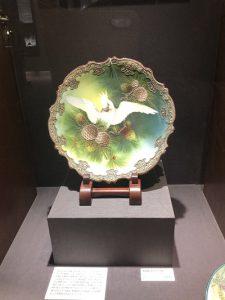
ミュージアム内は、陶磁器の製造過程の説明のコーナーや体験スペース、そしてかつてのオールドノリタケなどが展示されております。金点盛装飾などの技術を駆使した作品を拝見いたしました。西洋のテーブルウェアに少しでも近づこうとする日本の職人の足跡、それでいて日本らしい繊細さも諸所にあり、実に素晴らしかったです。
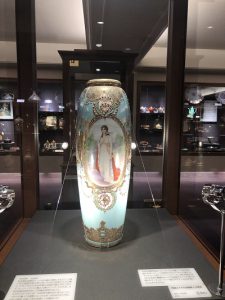
また、かつての生産されたディナーウェアなどの展示もしておりまして、その中には、かつて我が家にもあった懐かしいシリーズも幾つか探すことができました。皆様も、きっと「これ、我が家にある!」の一枚が見つかるかもしれません。
そんなミュージアムを含むかつての本社敷地内に、株式会社ノリタケカンパニーリミテドが創立100周年の記念事業として、2001年(平成13 年)10月5日、近代陶業発祥の地であるこの地に陶磁器に関する複合施設「ノリタケの森」をオープン。
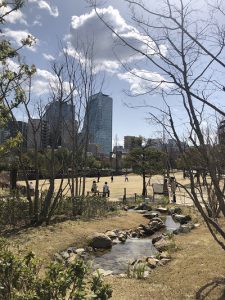
こちらの施設、名古屋駅から徒歩12分、亀島駅から徒歩6分、栄生駅から徒歩10分と主要三駅からアクセス可能な好立地でして、延床面積約14万m2広大な敷地に、文化と出会うカルチャーゾーン、暮らしを楽しむコマーシャルゾーン、歴史を感じるヒストリカルゾーンをコンセプトとして、新たな国内需要の発掘を実現する施策し、これまでとは異なる新たな商業施設開発と「働く人と企業の成長を支えるオフィス」を融合を目指すあたらしい地区を目指しております。
昨年末にはその中に商業施設も開業しており、この「森」はまだまだ進化し続けております。
訪れてみますと、観光をするところなのか、お買い物や食事をすることろなのか、働くところなのか、暮らすところなのか、その境界線はいい意味で曖昧。それらすべてひっくるめて複合した新施設の全体コンセプトは「自然と自然になれ楽しみ憩い働き生活する場所」といった印象でありました。
しかもその森の随所に、これまでもこれからも居続けるであろうかつてのノリタケの歩んできた歴史の片鱗が随所にのこっております。
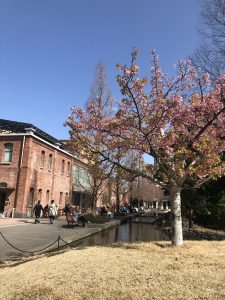
かつての、赤レンガ作りの赤レンガ建築(旧製土工場)(明治37年築)

6本煙突(陶磁器焼成用トンネル窯煙突の跡)(昭和8年~15年築)
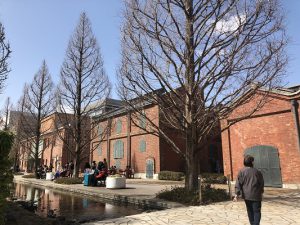 赤レンガ建築(旧陶磁器センター)(明治末期築)
赤レンガ建築(旧陶磁器センター)(明治末期築)
これらを含む建造物が、2012年6月ノリタケの森の下記の建造物が名古屋市の認定地域建造物資産として認定を受けております。これは、登録地域建造物資産(築50年以上経過した景観的・文化的価値のある建造物)の登録条件を満たし、かつ地域の歴史的、文化的な景観を特徴づけている建造物を対象にしたものに出す認定のようです。
また、輸出製品開発や国内需要拡大による中部、近畿、山陰の窯業近代化の歩みを物語る近代化産業遺産群としても、ノリタケの森の各建築物は認定や、その他様々な視点からの賞を受賞をしているようであります。2018年12月名古屋市から市民緑地認定制度による「市民緑地」のような緑地に着目した認定や、名古屋市都心部の貴重な緑豊かな空間として広く市民に親しまれる場となっている点を評価し、「公開性」「安全性」「環境への配慮」に優れ、人々に安らぎと憩いを与える貴重な環境資源である点が認められた公益財団法人都市緑化機構の社会・環境緑地「都市のオアシス2019」の認定などなど、都市設計においての新しい試みや、景観設計、緑地貢献など様々な方面からの賞を受賞をしているようです。
このような様々な受賞歴を鑑みても、こちらの森が新しい都市なのか、憩いをもたらす緑地なのか、文化的歴史的価値を残し伝承していく施設なのか、暮らすための商業エリアなのか、やはり境界線はいい意味で曖昧。その曖昧さが、私にはなんとも居心地がよかったのですが、それらすべての融合をめざし、誰もが自然に自由に訪ることのできる「森」を目指しているようですね。
そして、その森の中においてかつての煙突や製陶窯が今も静かに、ここで様々に過ごす人々を見守る姿が、大変印象的な佇まいでありました。
自然とここに訪れ、ここでどう過ごすかは自由。
「ノリタケの森」、名古屋に訪れた際には是非行かれてみてください。
それでは、こきげんよう。
Hello everyone, this is Staff Y.
He has lived in Nagoya for 15 years, but it seems that there are still places he has never visited. I went to “Noritake Garden” for the first time.
The other day, I talked about sightseeing in Nagoya, but when I visited Nagoya, it was close to Nagoya Station, and I really wanted you to visit it, so let me introduce it. Today is the eye of the photo.
Noritake is a domestic ceramics manufacturer that manufactures Western-style tableware that you all know.
In 1874 (Meiji 9), former merchant Ichizaemon Morimura, who was aspiring to trade abroad, founded Morimura Gumi in Ginza, Tokyo, and wanted to start manufacturing and exporting Western tableware in Japan. , Established “Nippon Seito Co., Ltd.” (currently Noritake Company Limited). The history of Noritake begins with a single dinner plate made there in 1904.
Staff Y, for the first time, I went to the Noritake Museum on the premises.
Inside the museum, there is a corner explaining the manufacturing process of pottery, an experience space, and the old Noritake. I saw a work that made full use of techniques such as gold dot decoration. The footprints of Japanese craftsmen trying to get closer to Western tableware, yet the Japanese delicacy was everywhere, and it was really wonderful.
We also exhibited dinner wear that was once produced, and we were able to find some nostalgic series that were once in our home. You may find one of “This is at home!”
On October 5, 2001 (Heisei 13), as a commemorative project for the 100th anniversary of Noritake Garden Co., Ltd., on the premises of the former head office including such a museum, a complex related to ceramics was created in this area, the birthplace of the modern ceramic industry. Opened the facility “Noritake no Mori”.
This facility is a 12-minute walk from Nagoya Station, a 6-minute walk from Kamejima Station, and a 10-minute walk from Sakou Station. Based on the concept of a culture zone where you can meet culture, a commercial zone where you can enjoy your life, and a historical zone where you can feel the history, we have taken measures to discover new domestic demand, develop new commercial facilities that are different from the past, and “workers and companies. We are aiming for a new district that aims to integrate “offices that support growth”.
At the end of last year, a commercial facility was opened in it, and it seems that this “forest” is still evolving.
When I visit, the line between sightseeing, shopping, eating, working, and living is very vague. The overall concept of the new facility, which is a complex of all of them, was the impression that “a place where you can enjoy nature, enjoy, relax, work and live”.
Moreover, everywhere in the forest, there is a glimpse of the history of Noritake, which has been and will continue to exist.
Former red brick building made of red brick (former soil factory) (built in 1897)
6 chimneys (traces of tunnel kiln chimneys for firing ceramics) (built in 1933)
Red Brick Architecture (former Ceramic Center) (built at the end of the Meiji era)
The following buildings in Noritake Garden have been certified as certified regional building assets in Nagoya City in June 2012. This is a building that meets the registration requirements for registered regional building assets (buildings with landscape and cultural value that are more than 50 years old) and that characterize the historical and cultural landscape of the area. It seems to be a certification issued to the target.
In addition, as a group of modern industrial heritage that tells the history of the modernization of the ceramic industry in Chubu, Kinki, and Sanin due to the development of export products and the expansion of domestic demand, each building in Noritake Garden has been certified and awarded from various perspectives. It seems that they have won the award. In December 2018, the city of Nagoya has been accredited by the citizen green space certification system focusing on green spaces such as “citizen green space”, and it has become a place that is widely loved by citizens as a valuable green space in the center of Nagoya city. The social and environmental green space of the Urban Greening Organization, which has been evaluated and recognized as a valuable environmental resource that is excellent in “openness,” “safety,” and “consideration for the environment,” and gives people peace and relaxation. It seems that it has received awards from various fields such as new attempts in urban design such as “City Oasis 2019” certification, landscape design, and contribution to green spaces.
Based on these various awards, is this forest a new city, a green space that brings relaxation, a facility that preserves cultural and historical value, and a commercial area for living? After all, the boundary line is ambiguous. The ambiguity made me feel at home, but it seems that I am aiming for a “forest” that aims to integrate all of them (whether the ambiguity is a good expression).
And, after all, the appearance of the former chimneys and pottery kilns still quietly watching over the people who spend various time in the forest was very impressive, and it was an ideal appearance.
What you do here is up to you.
Please visit “Noritake no Mori” when you visit Nagoya.
Well then, good luck.
**********************
暖かくなり、また新しい年度に向けてお片付けをはじめられた方もいらっしゃるのではないでしょうか。
生活様式の変化とともに、大切なお品を整理されている方も多いことと思われます。
ここ古美術風光舎では、古美術品や骨董品の他にも絵画や宝石、趣味のお品など様々なジャンルのものを買受しております。
お片付けをされていて、こういうものでもいいのかしらと迷われているものでも、どうぞお気軽にご相談下さいませ。
古美術風光舎は、出張買取も強化しております。
愛知県内はもちろん、岐阜県・三重県その他の県へも出張いたします。
どんなにご近所の方でもお伺いできますので、まずはお電話お待ちしております。
愛知県名古屋市千種区・骨董 買取
『古美術 風光舎 名古屋店』
TEL 052(734)8444
10:00-17:00 OPEN

